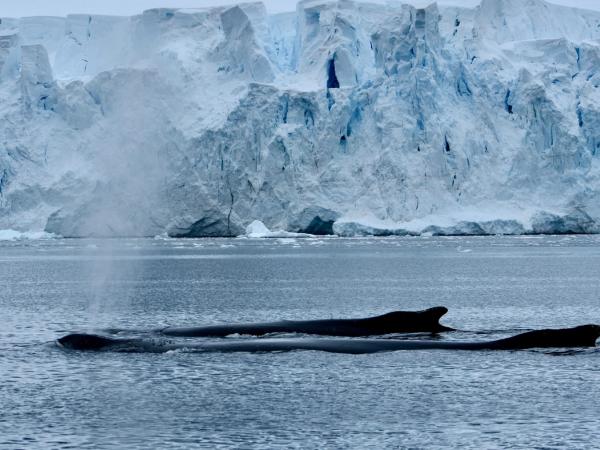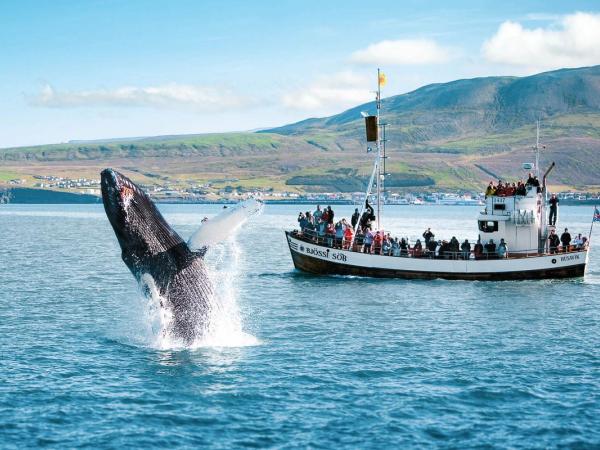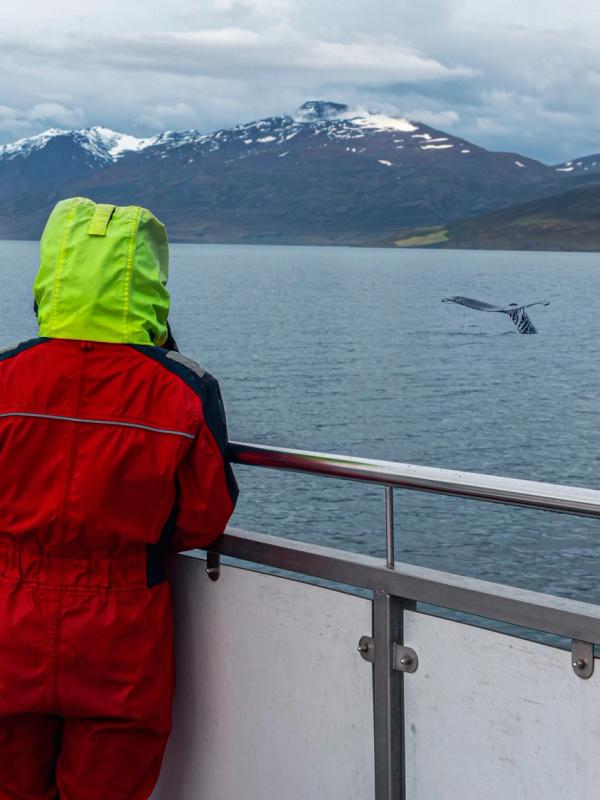
Whale Watching in Iceland: The Ultimate Guide (2025)
Iceland's waters are among the best spots in Europe to see whales. Thanks to its location between the Arctic and North Atlantic oceans, this island attracts many whale species looking for food. Whether you see a humpback jump or spot a group of orcas, I assure you that whale watching is bound to be one of the highlights of your trip.
Key Takeaways
- Iceland has about 20 whale and dolphin species, including minke, humpback, blue, fin, and orcas.
- The best spots are Húsavík (the "Whale Watching Capital of Europe"), Reykjavík, Akureyri, and the Snæfellsnes Peninsula.
- Go between April and October, with May to August being best, or winter for orcas.
- In 2025, tours cost around $100 to $110, with success rates up to 99% in peak season.
- Húsavík offers the best experience with almost 100% sighting rates and the most whale variety.
Why is Iceland a Great Place to See Whales?
Iceland sits where warm Atlantic waters meet cold Arctic currents, creating areas rich in food that attract whales from all over. This makes Iceland one of the most reliable places in Europe to see these amazing animals.
The country's many fjords and bays create calm waters where whales can feed and people can watch them easily. Iceland has also reduced commercial whaling in favor of whale-watching tourism, which has helped whale populations recover.
I went whale watching in Húsavík during May, and it was one of the best experiences of my life. Seeing three huge whales up close, plus lots of puffins at sea, is something I don’t think I will ever forget. The mix of Iceland's stunning landscapes with these ocean giants is truly special.

What Whales (and Similar) Can You See in Iceland?
Iceland's waters attract about 20 different whale and dolphin species. Here are the ones you're most likely to see:
Minke Whales
These smaller whales (23-26 feet long (7-8 meters)) are the most common in Iceland. They often swim near boats, giving you great close-up views. Minkes have white bands on their fins and feed near the surface on small fish and krill. They're quick swimmers and can be seen all season around the entire country.
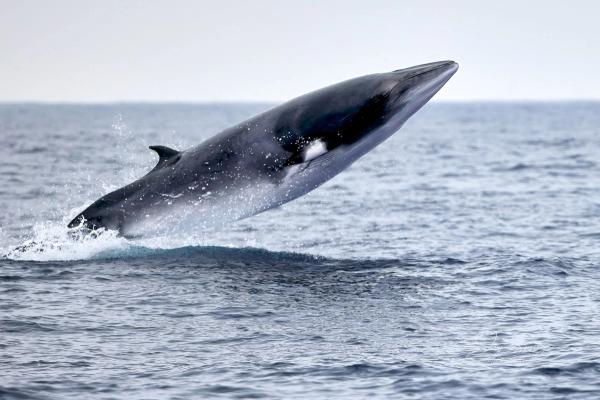
Humpback Whales
Known for their acrobatic moves, humpbacks (up to 52 feet long (16 meters)) are crowd-pleasers. They often jump out of the water, slap their tails, and wave their long fins. Each humpback has a unique pattern on its tail, like a fingerprint. They're commonly seen feeding in North Iceland, especially around Húsavík and Akureyri.

Blue Whales
The largest animals ever, blue whales, can reach up to 100 feet (30-31 meters). With only 10,000-25,000 left worldwide, they're harder to spot, but Iceland is one of the few places where you might see them, especially in North Iceland during summer. Their water spouts can reach 30 feet high (9 meters), making them visible from a great distance.
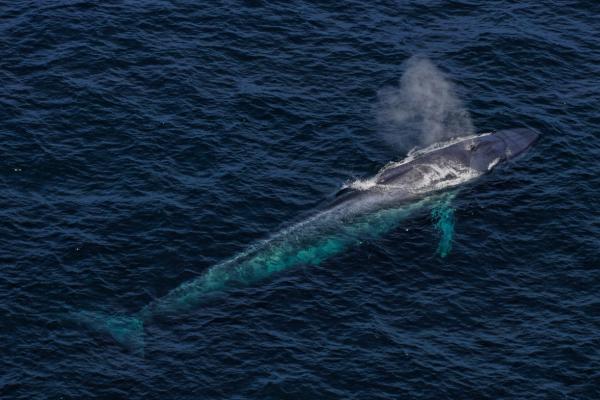
Orcas (Killer Whales)
These black and white hunters aren't actually whales but the largest type of dolphin. Orcas travel in groups of up to 40, each weighing up to 10 tons and measuring 32 feet long (10 meters). They're smart, social, and hunt together as a team. Snæfellsnes Peninsula is the best place to see orcas, especially during winter when they follow herring.
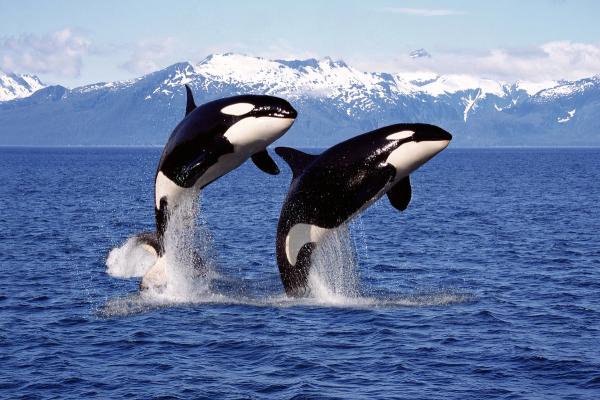
White-Beaked Dolphins
These playful dolphins often swim near boats to ride the waves. They travel in groups from a few to several hundred and love to jump and spin. Their white beaks and sides make them easy to spot even from a distance.

Harbor Porpoises
These shy, smaller sea mammals (about 5-6 feet long) are common in Iceland's coastal waters but harder to find because they're so shy. They don't usually approach boats and only surface briefly. If you watch carefully, you might see their small triangle-shaped fins break the water's surface.

Best Places to See Whales in Iceland
Wondering what the best place to do this amazing activity is? We’ve got you covered with this list. But don’t worry, you literally can’t go wrong.
Húsavík
Known as the "Whale Watching Capital of Europe," Húsavík almost guarantees whale sightings in Skjálfandi Bay. This northern town has expert guides who know exactly where the whales hang out. Humpbacks steal the show here, often jumping out of the water, alongside minkes, white-beaked dolphins, and sometimes blue whales in summer.
Tours last 3 hours, cost around $100 for adults and half the price for kids, and run from April to November with companies like North Sailing and Gentle Giants. The town also has a great Whale Museum where you can learn more about these sea giants. After your tour, enjoy the colorful houses and soak in the nearby GeoSea hot springs for a perfect day in north Iceland.
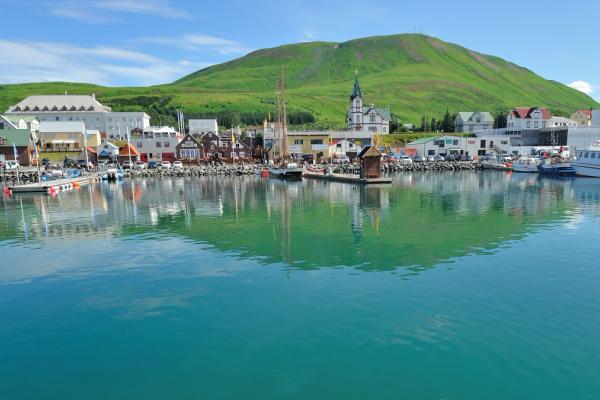
Reykjavík
The capital makes whale watching easy with tours right from the Old Harbor and a 99% summer success rate. This is perfect if you're short on time but still want to see whales. In Faxaflói Bay, you'll mainly see minke whales, along with humpbacks, white-beaked dolphins, harbor porpoises, and sometimes orcas in late winter.
Tours last 3-4 hours, and are a bit more expensive than in Húsavík ($100-$113), and many companies offer a free second trip if you don't see whales. Reykjavík's lively atmosphere and closeness to other attractions make it a great base. You can easily combine whale watching with puffin tours in summer or Northern Lights cruises in winter.
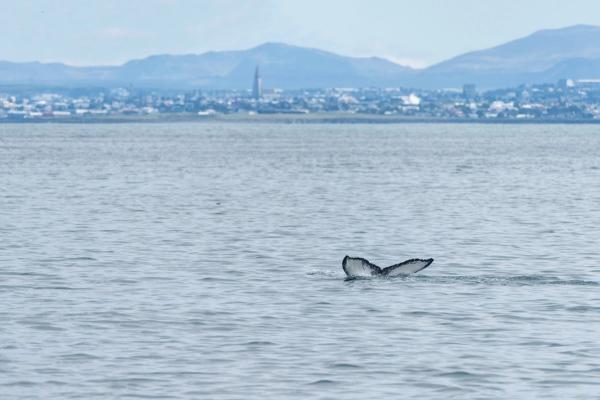
Akureyri
The central city in northern Iceland sits at the base of Eyjafjörður Fjord, where deep, calm waters attract big whales against a backdrop of mountains. The sheltered fjord helps tours run in good conditions, perfect for spotting humpbacks, fin whales, and even blue whales in summer, plus dolphins and porpoises year-round.
Tours run from April to October, last about 3 hours, and cost $95-$110. After seeing whales, explore the city, with its good restaurants, botanical gardens, and striking church, or use it as a starting point to complete the Diamond Circle route, which includes amazing spots like Lake Mývatn, Asbyrgi Canyon, and Dettifoss waterfall.
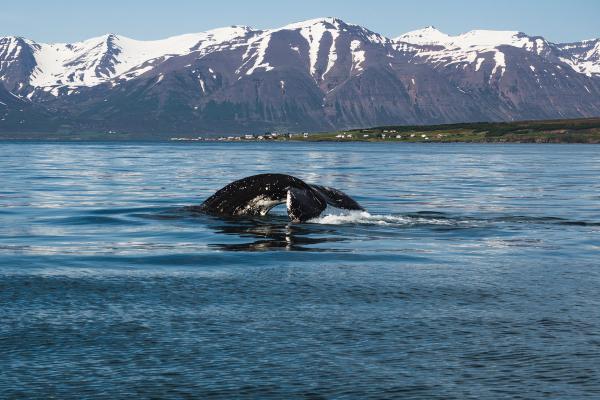
Ólafsvík (Snæfellsnes Peninsula)
Ólafsvík offers something special - winter orca watching. From January to March, up to 40 orcas gather in Breiðafjörður Fjord to hunt herring. The town gives you access to both sheltered waters and deeper ocean, where you might see orcas, sperm whales, minkes, humpbacks, and dolphins, depending on when you visit.
Tours cost $110 with companies like Láki Tours. The stunning Snæfellsjökull glacier and diverse landscapes around (black beaches, lava fields, and the famous Kirkjufell mountain) make this area worth exploring beyond whale watching. It's called "Iceland in miniature" for good reason.
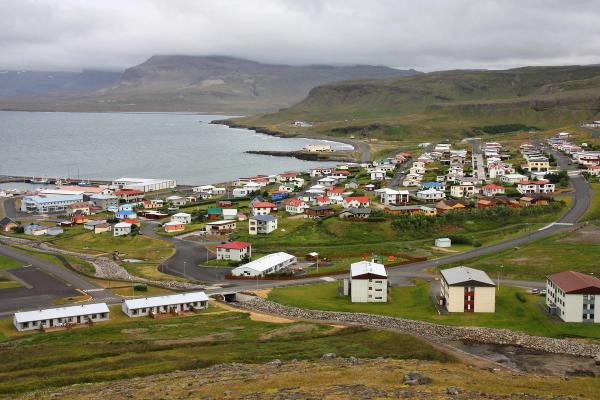
Dalvík
This small northern town near Akureyri offers whale tours with a more local feel and fewer tourists. Humpback whales, minke whales, and fin whales are common, with occasional blue whales in summer and dolphins and porpoises year-round. The deep waters nearby increase your chances of seeing whales, and with way fewer crowds than in Akureyri.
Tours with Arctic Sea Tours cost $94 for 3-hour trips and are available all year round, with some including fishing for a true Icelandic experience. This charming fishing town gives you a glimpse of real Icelandic life, and the nearby hiking trails offer more adventures after whale watching.
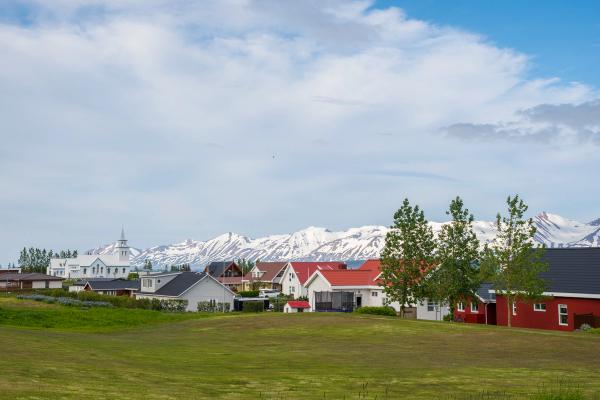
Westfjords
The remote Westfjords are perfect for watching whales away from the crowds, with tours from towns like Ísafjörður and Holmavík. The dramatic coastlines make a stunning backdrop for spotting minkes, humpbacks, porpoises, and winter orcas. With so few tourists, tours here often feel like private trips, and you might also see seals and many seabirds.
Tours cost around $110 and typically run from May to September when the weather allows. The Westfjords are one of Iceland's wildest regions, with few people and untouched nature. If you're willing to travel to this out-of-the-way area, I assure you you’ll see incredible scenery and wildlife that most visitors never see.

Best Seasons to See Whales in Iceland
Whales are not present all year round in Iceland, so it’s important to know exactly when to go.
Summer (May-August)
Summer is the best time for whale watching in Iceland. This is when migratory whales come to feed in the food-rich waters. The long daylight hours (including the Midnight Sun in June) give you more time to watch and better visibility.
This is when you're most likely to see humpbacks jump out of the water, plus minke whales, dolphins, and porpoises. Blue whales sometimes show up in North Iceland during early summer. Warmer weather (45-60°F/7-15°C) makes the tours more comfortable, and calmer seas mean better sighting chances.
Summer also brings more tourists and higher prices, so book early, especially for popular spots like Húsavík.
Spring/Fall (April-May & September-October)
These in-between seasons offer good whale watching with fewer crowds. Weather can be unpredictable, but tours still run regularly with good success rates.
Spring brings the first migratory whales back to Iceland, while fall sees them getting ready to head south. Minke whales and humpbacks are still common, though blue whale sightings decrease substantially. In early spring (March-April), you might still catch some orcas around the Snæfellsnes Peninsula.
Tours usually cost less during these times, and accommodation is easier to find. The trade-off is slightly colder weather and sometimes rougher seas.
Winter (November-March)
Winter offers a completely different whale watching experience, mainly focused on orcas. While many whale species head south, orcas follow herring schools to Iceland's western and southern coasts, especially around the Snæfellsnes Peninsula.
The snow-covered mountains create a beautiful backdrop for orca watching, and since the days are shorter and nights darker, there’s a big chance of seeing the Northern Lights on your return. Tours are less crowded, giving you more time with the guides.
The worst thing about winter tours is that tours face possible cancellations due to rough seas or storms. Not all companies run during winter, so you'll have fewer options.
Migration Patterns
Understanding when whales come and go helps you plan your trip:
- Humpback and Minke Whales: These whales visit Iceland mainly from April to October, with most showing up between May and August. They come to feast on the plentiful krill, plankton, and small fish in Iceland's waters.
- Blue and Fin Whales: These giants prefer the deeper waters of North Iceland, usually arriving in early summer (May-June) and leaving by September.
- Orcas: Unlike other species, orcas follow food rather than set migration routes. They show up around the Snæfellsnes Peninsula and southern Iceland mainly from December to March, chasing herring. Some groups stay year-round, but they're harder to find outside winter.
- White-Beaked Dolphins and Harbor Porpoises: These species live in Icelandic waters all year, though they move around between coastal areas following food.
What drives these migrations is simple: food. The mixing of ocean currents around Iceland creates perfect conditions for plankton blooms, which attract fish, which in turn attract whales. This feeding pattern makes summer best for most whale watching, while winter herring attract orcas during colder months.
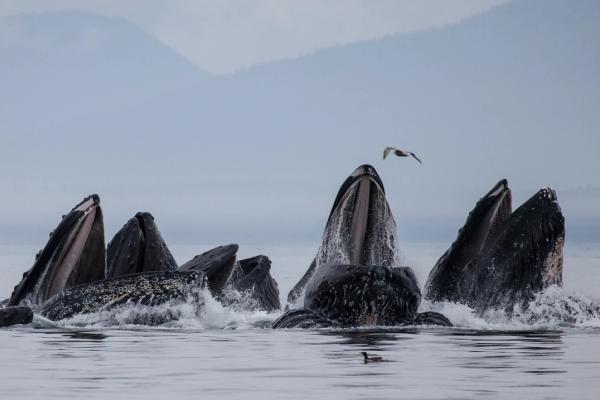
Tips for Whale Watching in Iceland
Some smart tips will make your trip more pleasing.
What to Wear:
- Dress in warm, waterproof layers, regardless of the season. Even summer days get cold on the water
- Wear a windproof jacket, hat, and gloves
- Bring sunglasses and sunscreen (yes, even in winter) as water reflection makes the sunshine stronger
- Many tour boats provide warm overalls, but bring your own layers underneath
Photography Tips:
- Bring a camera with a zoom lens if you can
- Use sports/action mode for faster shutter speeds
- Take lots of photos when whales appear – they don't stay still
- Keep your camera handy but protected from spray
- Use a strap or harness so you don't drop it
Seasickness Prevention:
- Take motion sickness pills an hour before the tour
- Stay in the middle of the boat where it's most stable
- Keep your eyes on the horizon, not down at your phone
- Skip heavy meals or alcohol before the tour
- Try ginger candies or sea bands if you're prone to seasickness
Maximizing Sightings:
- Listen to your guide – they know where to look
- Watch for blows (spouts) rather than trying to spot entire whales
- Look for groups of seabirds, which often means whales are feeding below
- Be patient – sometimes whales take a while to show up
- Stand on the upper deck, if possible, for a better view
Booking Advice:
- Book early for summer trips, especially in Húsavík
- Check cancellation policies since the weather can change plans
- Look for tours with "sighting guarantees" that offer a free second trip if you don't see whales
- Morning tours often have calmer seas
- Choose smaller boats for a more personal experience, or larger ones if you worry about stability
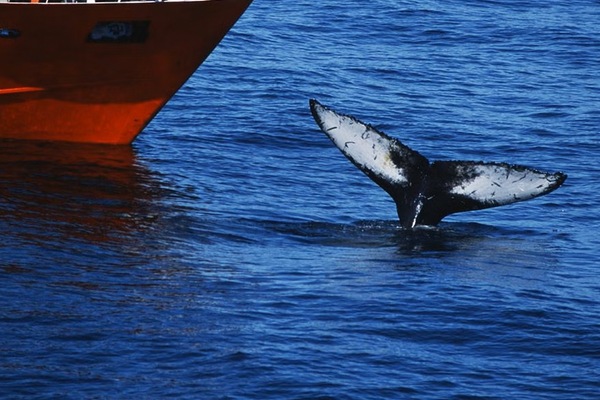
Conclusion
Whale watching in Iceland lets you see some of the world's most amazing creatures up close. Whether you pick Húsavík (the "Whale Watching Capital"), easy-access Reykjavík, scenic Akureyri, or orca-rich Snæfellsnes, you're in for something special.

